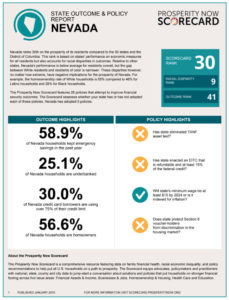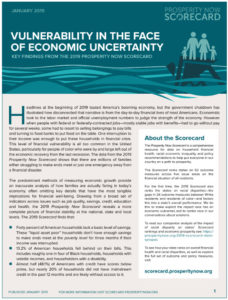Millions of U.S. Families Face Economic Uncertainty Despite Reports of a “Healthy Economy”
New Research Shows Exacerbated Vulnerability Along Racial Lines at State Level
Click Here for Nevada Scorecard 2019 | Click Here for Key Findings of 2019 Scorecard

Washington, D.C. – Despite headlines touting America’s booming economy, the reality is that millions in the US are living in financial uncertainty. According to new research from Prosperity Now (formerly CFED), an alarming number of families don’t have the resources to withstand an economic downturn, which many analysts predict is around the corner.
The 2019 Prosperity Now Scorecard shows that millions of families are either struggling to make ends meet, or are just one emergency away from a financial disaster. Forty percent of American households lack a basic level of savings. According to the Scorecard data, these “liquid asset poor” households don’t even have enough savings to live at the poverty level for three months if their income was interrupted. The data is even worse for people of color with nearly 57% of households of color being liquid asset poor.
For the first time, the 2019 Scorecard includes ranks the states on racial disparities—the gaps in 26 outcome measures between White residents and residents of color—and factors this into a state’s overall performance. Prosperity Now is increasing its focus on racial economic inequality because, as the data illustrates, structural inequality in the United States means that race and ethnicity have an outsized impact on economic well-being. Black, Latino, Native American, Native Hawaiian and Pacific Islander people fare worse across all Scorecard outcomes and issues.

“Even where there have been some gains, the gaps between White households and households of color have persisted or widened. It was time to be explicit about the impact race has on economic outcomes and to center race in our conversations about solutions,” said Kasey Wiedrich, Prosperity Now Director of Applied Research. “If this inequity is the reality during a ‘booming’ economy, how will households of color fare when the next economic downturn hits?”
The Scorecard also examines the policy choices of lawmakers at all levels of government.
Additionally, it illustrates how those choices affect the ability of households—especially households of color and those with limited income—to create a more prosperous future. The Scorecard recommends policies that first and foremost serve the individuals and families whose lives they intend to improve while also building economic strength and resiliency in the broader communities in which we live together.